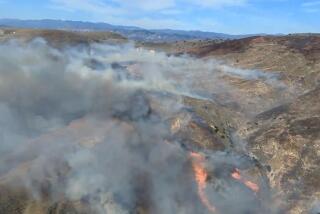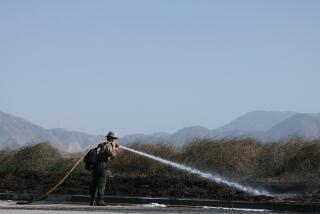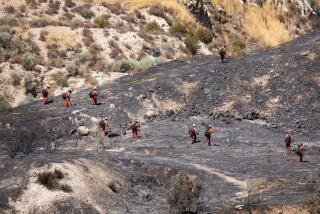A Rampage of Firestorms
A crescent of fire continued to rage through Southern California on Sunday, destroying hundreds of homes, claiming at least 11 more lives and throwing the entire region into an eerie, smoky half-light.
A searing Santa Ana wind blew flames over mountain slopes like an incandescent hurricane, burning more than 500 homes and bringing the fires’ two-day toll to more than 700 buildings. The combined fires stretched over 250,000 acres -- about half the size of Rhode Island -- in an arc from Ventura County to the Mexican border.
More than 5,000 firefighters battled the infernos, at least two of which were believed to have been caused by arson. Veteran fire officials described them as the most awesome and unstoppable blazes they had ever seen. Weather forecasts call for high winds and heat today.
“It goes wherever it wants to go and consumes whatever it wants,” Capt. Doug Johnston of the Kern County Fire Department said of one of the largest fires, in San Bernardino County. “It’s humbling. There’s only so much you can do with a wind-driven fire like this.”
The fires did their worst damage, in terms of property loss, along the ragged fringe of mountain slopes where suburbia meets the wilderness -- a classic Southern California landscape that has long lured people to build homes in forest and brushland despite the likelihood that they eventually will be threatened by fire.
“It was lush,” Donald Carpenter said as he surveyed the charred remains of his 2 1/2-acre hillside garden in Claremont. “Now it’s ash.” And Carpenter was lucky: The fire stopped just short of his house.
At least nine fires in six counties disrupted the lives of untold thousands. In San Bernardino County alone, 40,000 people were evacuated. The fires:
* Caused delays and flight cancellations at Southern California airports after flames forced the closure of a major air traffic control center near San Diego.
* Closed numerous highways, including portions of Interstates 15 and 215 in San Bernardino County, re-routing drivers returning from Las Vegas.
* Forced the closure of hundreds of schools in many areas today, including Cal State San Bernardino.
* Halted rail traffic through the Cajon Pass, one of the main freight thoroughfares connecting Southern California ports with the rest of the country.
* Prompted warnings against outdoor exercise throughout Southern California.
Gov. Gray Davis declared states of emergency in San Bernardino, Ventura, San Diego and Los Angeles counties. He also asked President Bush to declare a federal disaster area for much of Southern California, clearing the way for federal assistance.
“Our hearts go out to you,” Davis told evacuees who stayed overnight at San Bernardino International Airport. “I know what it’s like to have to leave your home.” Davis was referring to the 1994 Northridge earthquake, which damaged his West Hollywood condominium.
Davis said Gov.-elect Arnold Schwarzenegger will be in Washington on Tuesday, and will lobby for federal assistance. A spokesman for Schwarzenegger said the governor-elect was receiving regular briefings from Dallas Jones, the head of the state Office of Emergency Services.
The most deadly of the fires rampaged through dry brush in northeastern San Diego County. At least 11 people died in the Cedar and Paradise fires, most trapped in their cars as they tried to flee. The worse of the two, the Cedar fire, also destroyed about 50 homes in Ramona and the Scripps Ranch and Tierrasanta neighborhoods of San Diego.
More destructive in terms of property loss were twin blazes centered in San Bernardino County. The two converged Sunday when the Old fire, the more easterly of the two, jumped the 215 Freeway near Devore and touched the Grand Prix fire, said Norm Walker, a division chief with the U.S. Forest Service.
The two fires created a contiguous band of more than 60,000 blackened acres from Claremont in the west, where fire crews managed to gain control over the firestorm, to Running Springs in the east, where the blaze continued to burn out of control between Lake Arrowhead and Big Bear. A smaller fire destroyed homes in Crestline, raising fears that one or another of the fires could sweep unchecked through the popular resort communities around Lake Arrowhead, where fire officials have been sounding alarms for years about a buildup of brush and dead trees.
Another major fire raged in Ventura County, charring at least 90,000 acres of hillsides and rangeland, destroying or damaging eight homes and prompting evacuation of a county jail and neighborhoods in Fillmore, Moorpark, Santa Paula and Simi Valley.
At one point Sunday, the fire approached the Ronald Reagan Presidential Library in Simi Valley, but eventually was beaten back without causing any damage there. Other, smaller fires charred brushland in Chatsworth, Malibu, parts of Orange County and the remote Riverside County community of Sage, near Hemet. The Sage fire scorched 3,000 acres and destroyed six structures.
San Bernardino/L.A. County Fires
In the parking lot of the San Bernardino County Fire Department’s Devore Station No. 2, firefighter Tom Pitts watched Sunday as a wall of flames raced toward him. “It has been kicking our butts,” he said of the fire.
Pitts was asked whether anything could stop it. “No,” he said, “not without this wind stopping.”
The Old fire, which began early Saturday, allegedly by an arsonist, swept with breathtaking speed as it headed north into Devore, a roadside hamlet near the intersection of the 15 and 215 freeways. Firefighters made an aggressive attempt to stop the forward progress of the fire, with at least 15 water drops from helicopters on the front edge. They used helicopters because the winds were too strong for fixed-wing aircraft, which can carry more water.
The initial efforts failed, but by late Sunday, fire officials said they appeared to be making modest progress in stopping the advance of the fire.
Brian Scroggins, 30, stood on the fender of his truck, parked in the driveway of his small house in Devore, as he watched the fire come down off the hills and approach his neighborhood. He was alternating between urging on the helicopters -- “Come on guy, get on that, get on that!” -- and praying. “God,” he beseeched, “I don’t want to lose my house. Save my house, Lord, please save my house.”
Scroggins had to hold on to the truck to prevent 50 mph winds from blowing him off as the neighborhood became enveloped in ash and smoke.
Not far away, in the foothills above the 215 Freeway, was a lunar landscape of charred ground and the skeletons of burned trees. The Old fire had destroyed more than 450 homes from the El Cajon Pass to Running Springs by Sunday night, officials said.
Firefighters said their biggest problem was the obvious one: high winds. But beyond that, the weather patterns also were producing an unusually shifty and unpredictable fire, they said. Late evening humidity, among the usual allies that firefighters rely on in California, was nowhere to be found. “Mother Nature is playing games with us,” said Capt. Wayne Parks of the California Department of Forestry’s Tulare unit.
By midafternoon, the eastern edge of the rustic community of Crestline on Rim of the World Highway was ablaze. At least 25 homes had been destroyed in the fire, which was near, but distinct from, the Old and Grand Prix fires. Arson was among the possible causes being investigated.
“This is our worst nightmare,” said Tricia Abbas, a spokeswoman for San Bernardino National Forest. “This is everything we didn’t want here: Santa Ana winds, dead forest, high temperatures.”
The fires displaced, at least temporarily, thousands of people, at least 450 of whom crammed into a small hangar at San Bernardino International Airport that had been converted into a refuge.
The smell of ash and body odor permeated the air of the hangar, where scores of green Army cots covered with dark gray blankets had been placed in rows. Some of the displaced came with their own pillows. One cot was spread with a pink Disney Princess blanket.
The concrete floors were sticky from spilled soda and coffee, donated by restaurants and churches. Boxes with pepperoni pizza, packets of cupcakes and bottled water lay scattered across folding tables in an old office that had been turned into a concession stand.
San Bernardino Mayor Judith Valles arrived at the shelter with bad news. “I want to warn you that in the city of San Bernardino we have 300 to 400 homes lost,” she told a crowd at the center, as gasps filled the air. She said the city would provide a list of damaged homes later.
Firefighters with 30 or more years experience said the combined San Bernardino fires are the worst they have seen, said Greg Cleveland, a spokesman for the fire forces’ central command. “This fire will most definitely be a historic one,” he said. “It will be referred to for many, many years.”
Firefighters from nearly every county in California are fighting the fire, authorities said.
San Diego County
Residents of northern San Diego County awoke Sunday to wind-whipped flames racing toward homes and news that two major brush fires had broken out over night. It was soon clear that few, if any, firefighters were available to stop the advancing flames.
Eleven people were reported killed by the fires by late Sunday, including two children, bringing the overall death toll from the Southern California fires to at least 13. Two people died Saturday in San Bernardino.
As some homeowners tried Sunday to fight the flames with garden hoses, San Diego Mayor Dick Murphy pleaded for residents to flee. “Your life is more important than your house,” he said.
By late Sunday, 175,000 acres had burned in fires in the northern part of San Diego County and near the U.S.-Mexico border. About 300 homes were destroyed or damaged.
Dark, greasy smoke drifted for miles, casting a pall over much of the county. Lindbergh Field, the city’s international airport, was closed. Thousands of homeowners were ordered to flee. The American Red Cross set up several evacuation centers, and the Navy opened its bases for military personnel routed from their off-base homes.
As the fires raged, a small plane crashed on California 163 while trying to land at Montgomery Field. The pilot, who survived, indicated that he became disoriented by the large amount of smoke in the flight pattern.
In the parking lot of Qualcomm Stadium, where 5,000 people were urged to take shelter, people looked northward at the dark smoke that covered the neighborhoods they had just been forced to abandon. Tonight’s Chargers football game against the Miami Dolphins was moved to Tempe, Ariz.
Frustration began to set in from a lack of information. Rumors spread quickly. Many people had the same story: Their dream homes were going up in flames. “It was burning in a beautiful new neighborhood,” said Bill Fitzpatrick, who fled with his wife, pictures and two dogs. His wife hurriedly packed her wedding dress, but in the rush to escape the flames had left it behind.
Ventura County
In Ventura County, firefighters fared better than elsewhere, successfully defending many neighborhoods by day’s end.
Still, six mobile homes were destroyed and another eight homes at least partially burned.
At the fire’s westernmost point in Santa Paula, flames popped like boiling grease as they scorched bamboo in the Santa Clara River bed, sending coyotes scampering for cover and threatening houses on the river’s edge.
By Sunday night, at least 600 firefighters had joined the fray. A fire near Fillmore and one approaching Rocky Peak at the Los Angeles County line appeared threatening to residences, and crews were shifted to halt movement toward homes.
Throughout the day, a smoky sky rained ash on nearly all of populated Ventura County, as the so-called Simi fire spread in all directions.
The Ronald Reagan Freeway was shut down Saturday afternoon, and fire crews dispatched to Rocky Peak worked frantically to keep the blaze from skipping over the Los Angeles County line and into an exclusive housing development.
As evening approached, and fire reached the doorsteps at the sheriff’s Todd Road Jail near Santa Paula, deputies transferred 821 inmates in secured buses and vans to the Central Jail in Ventura.
And a separate fire near Lake Piru that began Thursday and had been burning north into steep terrain in Los Padres National Forest did a turnabout and began racing southwest toward Fillmore late Sunday afternoon. The fire, which crews had mostly contained hours earlier, had burned more than 10,000 acres by nightfall, U.S. Forest Service officials said.
Sheriff’s spokesman Eric Nishimoto said that, overall, Ventura County fared relatively well considering the scope of its fires and the tinderbox dryness of its terrain.
The Ventura County fire, compared with the San Bernardino area, burned primarily in open grazing land and undeveloped areas.
But as the day wore on, he said, fire and law enforcement crews were struggling to keep ahead of the blaze as it grew in every direction, virtually encircling Simi Valley.
High winds pushed the Simi fire westward over brush-covered hill toward Santa Paula, where residents rushed to save homes, barns, livestock and crops.
At a wood barn where children in 4-H and Future Farmers of America keep their livestock, more than a dozen youths, parents and teachers worked to evacuate the animals.
Santa Paula High School agriculture teacher Alex Flores arrived at the barn just as flames were cresting South Mountain and racing toward the barn. After loading 10 steer and 30 sheep onto trailers, Flores tried to hustle volunteers out. But retired truck driver and FFA parent Terry Weaver refused to leave.
“I told the kids I’d save this place, and that is what I am going to do,” Weaver said as he wet down the wooden structure with a hose.
More to Read
Start your day right
Sign up for Essential California for news, features and recommendations from the L.A. Times and beyond in your inbox six days a week.
You may occasionally receive promotional content from the Los Angeles Times.








